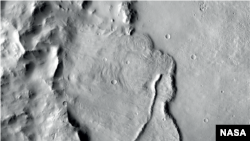For years, Mars has been seen as a dry, lifeless planet. But there is growing evidence to suggest this was not always the case.
Scientists have already collected evidence suggesting that Mars once had a lot of water. Now, European researchers say they have discovered the first evidence of a huge groundwater system that once existed below the planet’s surface.
The European Space Agency, or ESA, says its Mars Express spacecraft helped discover the evidence. It said a new study provides the first geological proof that Mars once had a “planet-wide groundwater system.”
The study was a project of researchers from Utrecht University in the Netherlands. Francesco Salese and his team studied images of 24 deep craters in the northern half of the Red Planet. These pictures were captured by ESA’s Mars Express orbiter, which was launched in 2003.
Salese is a geologist. He says scientific evidence already suggests Mars was once a watery world. “But as the planet’s climate changed, this water retreated below the surface to form pools and ‘groundwater.’”
His team says the images showed that large amounts of continuous groundwater activity connected the areas they studied. Evidence of basins and coastlines was also found on the surface of Mars, supporting the idea that water was once present.
“There is no evidence that they had been filled from the surface, so upwelling ground water is the only remaining explanation,” Salese said. He added that all the basins seemed to reach about the same height. This likely meant one large groundwater body once spread across the planet.
The water levels seem to support evidence that an ocean may have existed on Mars between 3-4 billion years ago.
Scientists have yet to find out what happened to all that water. “That’s the big question,” said Salese. “We’ve been able to determine that the ground water system we’ve discovered dates from around 3.5 billion years ago, but we don’t know when or how the basins dried up.”
Earlier research involving modeling experiments did not provide clear evidence that large bodies of water on Mars were interconnected. The latest study provides the strongest evidence yet that such bodies were linked over large areas of Mars.
Scientists have long linked the complex history of water on Mars to whether or not life ever existed on the Red Planet.
During the latest study, researchers discovered evidence of minerals within some of the identified bodies of water. Some of the same minerals have been linked to the beginnings of life on earth.
The researchers say the finding adds weight to the idea that the water basins on Mars may have once held the materials required to support life. Some of this material could still be buried on Mars, providing possible evidence of life during future exploration.
Francesco Salese believes the latest findings are not only exciting for what they teach us about Mars. He says the information could also help us learn new things about our own planet.
“As we learn more about water on Mars - especially the reason why we see so little of it on the planet today - we may be able to find out if the same can happen to Earth, or if it had already happened when Earth was still very young,” he said.
I’m Bryan Lynn.
Bryan Lynn wrote this story for VOA Learning English, based on the scientific study and information from the European Space Agency. George Grow was the editor.
We want to hear from you. Write to us in the Comments section, and visit our Facebook page.
_________________________________________________________________
Words in This Story
retreat – v. to move back or withdraw
basin – n. low area of land from which water flows
determine – v. discover the facts or truth about something
geologist – n. a scientist who has studied rocks and soil in order to learn about the history of planets
crater – n. a large hole in the ground











